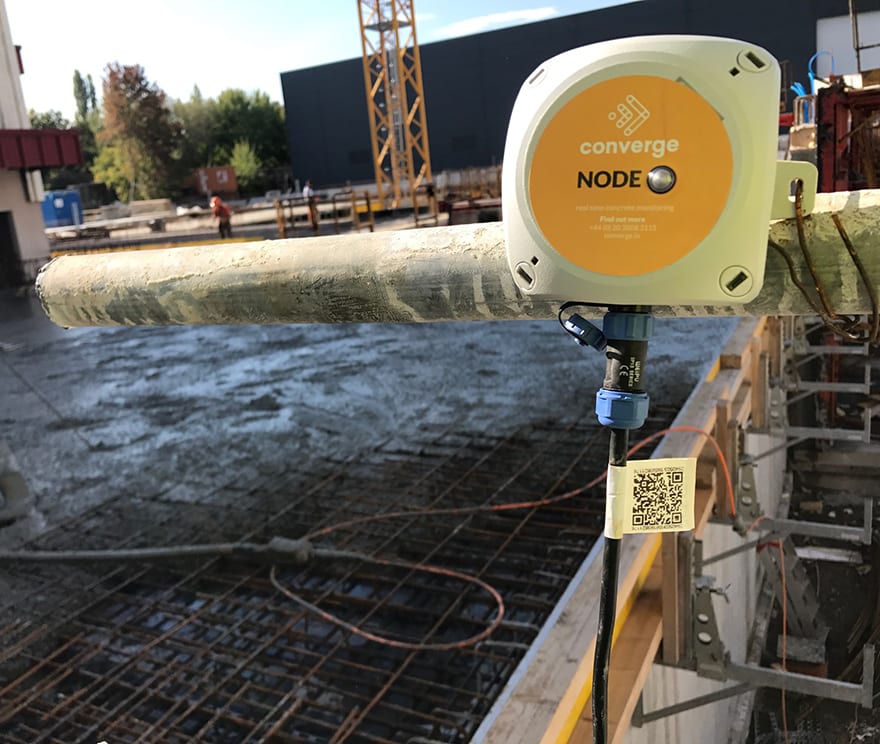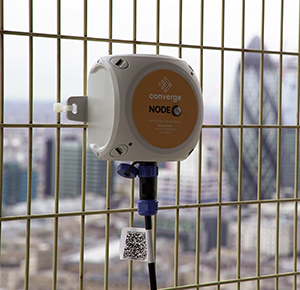A former prototype method of testing concrete strength using internet-connected sensors and processing power has been commercially deployed on around 40 construction projects across the UK.
The innovative technology, developed by UK tech start-up Converge, is based around a transmitter node that communicates data from sensors embedded in concrete over a mesh network.
The results are interpreted in real-time using sophisticated data analytics software to give an accurate real-time picture of the curing process and when formwork is ready to be struck.
After initial trials with a major contractor in 2015 the system has been deployed on projects including Hinkley Point C, the £1.7bn Royal Albert Docks development, 22 Bishopsgate and several Underground maintenance projects for Transport for London.
Raphael Scheps, co-founder and chief executive of Converge, told BIM+: “A year and a half ago it was only a prototype that worked but had not been battle tested. Some 40 sites on and the main thing we have achieved is reliability, by extended the range significantly and adding redundancy at multiple layers of the network.
“Our customers are striking concrete on the basis of our data and if they haven’t got reliable data they can’t make the important decisions.”
At Royal Albert Docks, Converge installed sensors in the post-tensioned concrete floor slabs, working with contractor Brookfield Multiplex and its concrete subcontractor to alter concrete mix designs to even out curing times over the summer and winter.
“Ask any engineer on site and they would tell you that concrete cures slower in winter than in summer but if you asked them to estimate how much slower they would have to guess,” said Scheps. “Our accurate measurements enabled the project to achieve consistent floor cycle times and meet the overall target programme.”

After initial trials with a major contractor in 2015 the system has been deployed at around 40 sites
The system was used by TfL to help tunnel maintenance workers achieve rapid formwork striking times during the tight windows they were allowed to enter the tunnels, at weekends and nights.
Temperature data from sensors installed in the concrete was relayed long distances over a network of repeaters running from above ground down into the tunnel. The Converge platform worked out strength estimates and key strength milestones were sent to the team as text and email alerts.
The contract at Hinkley involves nuclear safety concrete and very large pours. “Converge is able to monitor temperature differentials across concrete, if the differential is too high it can result in thermal cracking that reduces the quality of the structure and its lifetime. That’s especially relevant for large concrete components on a site like Hinkley,” said Scheps.

A transmitter node communicates data from sensors embedded in concrete
On the £21m Ipswich Tidal Barrier project, currently being delivered by VBA, a joint venture between VolkerStevin, Boskalis Westminster and Atkins, concrete data processed by Converge was used to challenge existing standards related to concrete shrinkage.
A detailed temperature profile of the scheme, across the various concrete pours, was used to understand the impact of temperature differentials on shrinkage. Atkins used the data to challenge the accuracy of existing CIRIA standards on concrete shrinkage.
Converge aims to make several advances over existing methods of concrete maturity (ie strength) testing.
Traditionally the process was done either by crush testing samples in the lab, or using embedded sacrificial temperature sensors in concrete. Both processes are manual and relatively time consuming, the latter requiring section engineers to plug handheld monitors into the embedded sensors on site, then return to the office to analyse the data.
Converge sensors connect to a small node running a wireless mesh network that sends data direct to its servers to be analysed in real time.
The network runs on a low radio frequency, of 868MHz, to enable uninterrupted transmission through concrete and steel. The firm claims the node can run several years on a single battery and transmit even in the harshest site conditions.
“The web platform is the biggest value add for our client base, they can log in from anywhere, on a phone or PC, and see how their concrete slab is doing,” Scheps concludes.











